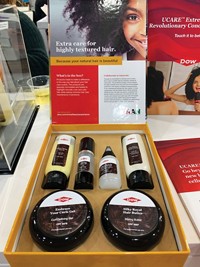Advertisement
Grab your lab coat. Let's get started
Welcome!
Welcome!
Create an account below to get 6 C&EN articles per month, receive newsletters and more - all free.
It seems this is your first time logging in online. Please enter the following information to continue.
As an ACS member you automatically get access to this site. All we need is few more details to create your reading experience.
Not you? Sign in with a different account.
Not you? Sign in with a different account.
ERROR 1
ERROR 1
ERROR 2
ERROR 2
ERROR 2
ERROR 2
ERROR 2
Password and Confirm password must match.
If you have an ACS member number, please enter it here so we can link this account to your membership. (optional)
ERROR 2
ACS values your privacy. By submitting your information, you are gaining access to C&EN and subscribing to our weekly newsletter. We use the information you provide to make your reading experience better, and we will never sell your data to third party members.
Business
Color Protection
ISP repurposes a hair conditioner to protect dyed hair from fading too quickly
by Marc S. Reisch
June 9, 2008
| A version of this story appeared in
Volume 86, Issue 23
IT HAS BEEN a source of frustration for years: Permanent oxidative hair dyes—the most widely used type of hair coloring—are not so permanent. Lush, colorful hair begins to look drab weeks before roots grow out.
Last month, at the New York Society of Cosmetic Chemists' Suppliers' Day Show in Edison, N.J., ingredient supplier International Specialty Products brought the issue to the fore with a new hair-color protection system it calls ColorTrue Technology. The first example of what ISP promises will be a line of hair-color protection systems, ColorTrue is based on an existing hair-conditioning polymer that delivers up to a 50% improvement in color longevity compared to unprotected hair.
According to Nancy Clements, ISP's global marketing director for personal care, the company scanned its existing product line for polymers that could be incorporated into a hair-color protection system. It settled on its Styleze W, a terpolymer of vinylpyrrolidone, dimethylaminopropyl methacrylamide, and methacryloylaminopropyl lauryldimonium chloride.
Clements says ISP then came up with an antifade package that customers could use consisting of three parts—a gel or mousse, followed by a shampoo and then a conditioner—all of which contain Styleze. Styleze "forms a hydrophobic and substantive barrier on hair," effectively reducing wash out of the hair dye, she says.
Globally, consumers spend about $11.6 billion on hair dyes, yet they often become unhappy when the dyes fade too soon, says Gillian S. Morris, chemical and materials director of consulting firm Kline & Co. That market figure doesn't include hard-to-count beauty salon dye jobs where customers can spend as much as $400 to color their hair.
Oxidative hair dying, which refers to the oxidation of melanin in hair shafts, has the lion's share of the market. At home or in the salon, it is an "aggressive" process that can damage hair, Morris points out. Protecting that investment and lengthening the time between touch-ups can provide a great benefit, she says.
ISP's foray into the dyed-hair protection business introduces a new ingredient among products already offered by National Starch Personal Care, Dow Corning, Momentive Performance Materials, Nalco, Croda, and Ciba.
Back in October, for instance, National Starch released a study showing the protective benefits of one of its conditioning polymers, Celquat LS-50, as part of a leave-in hair mousse regimen. At the time, Maria Tolchinsky, a global marketing manager with National Starch, pointed out that interest in the category is huge. Between June 2006 and October 2007 alone, hair-care companies launched 172 color-protection products.
Some of those products took advantage of other film-forming ingredients already on the market, such as silicones that Ciba supplies, according to Colleen Rocafort, the company's global polymers business head. Incorporated into shampoos, conditioners, and styling gels, such materials help prevent dye from leaching out when hair is washed, she explains.
OTHER APPROACHES to hair-color retention in the six to eight weeks before most customers' roots grow out include systems to lock dye more deeply into the hair cortex to resist wash-out. Croda, for instance, brought out such an oxidative hair-dye aid in 2005 when it introduced a phosphate-ester-based color enhancer called Crodafos HCE.
Ultraviolet light degradation of hair can be a problem depending on how much light the hair is exposed to. Some formulators actually incorporate traditional UV-absorbing sunscreen chemicals, normally used in skin-care products, into shampoos and conditioners.
About four years ago, however, Nalco designed a polymeric UV absorber specifically for hair. According to Tammy Gaffney, senior product manager in Nalco's performance products group, many UV absorbers easily wash off hair. Nalco's Solamer UV absorber has a cationic charge, and when formulated into a shampoo, it locks onto hair, she says.
With its introduction of ColorTrue technology, ISP has added one more option to the growing roster of ingredients intended to make "permanent" dyes just a bit more permanent. The success and growing use of these agents may help ingredient makers and product formulators turn a source of frustration for consumers into a source of income for the hair-care industry.






Join the conversation
Contact the reporter
Submit a Letter to the Editor for publication
Engage with us on Twitter